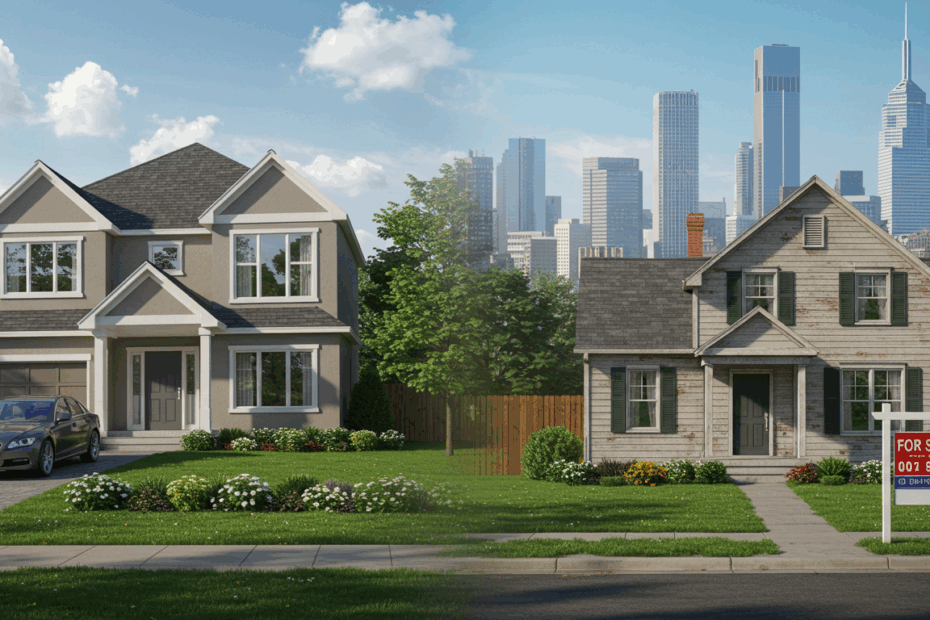A Tale of Two Homeowners: Understanding the “Housing Haves and Have-Nots”
Hi everyone, John here! Today, we’re diving into a topic that affects nearly everyone, whether you own a home, rent an apartment, or dream of buying your first place someday. We’re talking about the housing market. But we’re going to look at it through a unique lens provided by a recent article: the idea of “Housing Market Nobility.”
It sounds a bit grand, doesn’t it? But it points to a simple, powerful idea: the housing market has split people into two main groups. The original article cleverly calls them the “housing haves and have-nots.” Let’s break down what that means in a way that’s easy to grasp.
The “Housing Haves”: Riding the Escalator of Homeownership
So, who are the “haves” in this situation? Think of them as people who already own a home, especially if they bought it several years ago. They got on the property ladder before prices and interest rates shot up.
Imagine the housing market is like a big, steadily rising escalator. The “haves” got on this escalator early. Now, as the escalator moves up (meaning, as property values increase), their personal wealth grows along with it, often without them having to do anything extra. It’s a pretty nice ride to be on!
Here are some of the major advantages they enjoy:
- Building Equity: With each mortgage payment, they own a little bit more of their house. Plus, as the home’s value increases, their wealth grows. This is called building equity.
- Lila: “John, hold on. What exactly is ‘equity’? It sounds like a complicated finance word.”
- John: “Great question, Lila! Think of it like this: Imagine your home is a pizza worth $300,000. You still owe the bank $200,000 for it. The part you truly ‘own’—the $100,000 difference—is your equity. It’s the value of your home minus what you still owe on it. It’s a powerful form of savings!”
- Stable Housing Costs: If they have a fixed-rate mortgage, their main housing payment stays the same for decades. Meanwhile, renters often see their monthly payments go up year after year. This stability makes budgeting much, much easier.
- A Financial Safety Net: That equity we just talked about? It isn’t just a number on paper. It can be borrowed against for major expenses like a child’s education, a medical emergency, or home renovations. It’s a financial cushion that renters just don’t have.
The “Have-Nots”: Trying to Climb the Stairs
On the other side, we have the “have-nots.” This group includes first-time homebuyers, young people, and long-term renters who feel like homeownership is slipping out of reach.
To continue our analogy, if the homeowners are on the rising escalator, the “have-nots” are on the staircase right next to it. They are trying to climb, but the escalator is moving up faster than they can run. Every time they save a bit more for a down payment, home prices seem to have jumped even higher.
They face a completely different set of challenges:
- The Down Payment Hurdle: Saving a lump sum for a down payment is one of the biggest challenges. It’s tough when rising rent, student loans, and everyday costs eat up so much of your income.
- Rising Interest Rates: Even if they save enough, higher interest rates mean the monthly mortgage payment will be much larger than it would have been a few years ago for the exact same house. This can make an already expensive home completely unaffordable.
- The Rent Trap: As rent increases, it becomes harder to save money. This creates a frustrating cycle: you need to save to escape rising rent, but rising rent is preventing you from saving.
What Is This “Housing Market Nobility”?
This brings us to that fascinating phrase from the article’s title: “Housing Market Nobility.” It’s a powerful way to describe the deep divide we’ve been talking about.
In the old days, nobility was a class of people who had wealth, land, and power simply because they were born into the right family. That wealth was then passed down through generations, making it very difficult for anyone on the outside to join their ranks.
The article suggests that today’s housing market is creating a similar dynamic. Homeowners—the “haves”—are like a modern-day nobility. They possess a valuable asset that grows in wealth and provides security. They can pass this wealth on to their children, giving them a huge head start in life.
Lila: “So, it’s not saying homeowners are acting like royalty or that they’re better people, right? It’s more about the financial system itself creating this exclusive club?”
John: “You’ve hit the nail on the head, Lila! It’s not a judgment on individuals at all. It’s a commentary on the structure of the market. Owning a home has become such a powerful driver of wealth that it creates a divide that feels almost as rigid as the old class systems. Your financial future can be dramatically different simply based on whether you managed to buy a home, and when.”
A Few Final Thoughts
John’s Perspective: “This ‘haves and have-nots’ dynamic is something I see affecting people’s financial plans all the time. It really reinforces the idea that your home is more than just a place to live; for many, it’s the cornerstone of their wealth. It highlights how timing and luck can play just as big a role as hard work and savings.”
Lila’s Perspective: “As someone who is currently renting and saving, this all feels very real. The ‘staircase next to the escalator’ is the perfect analogy! It can feel a bit discouraging, but understanding the system is the first step toward figuring out a realistic path forward.”
This article is based on the following original source, summarized from the author’s perspective:
Housing Market Nobility
